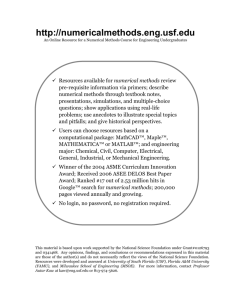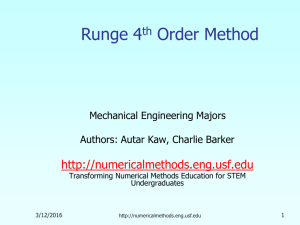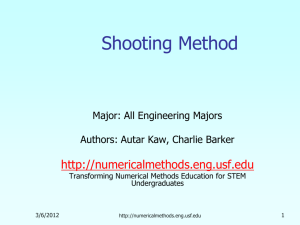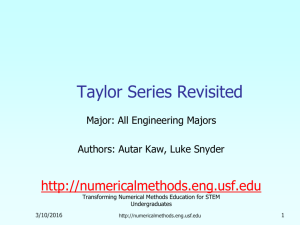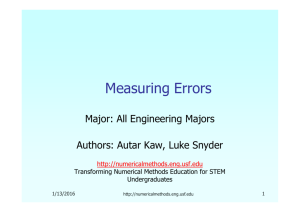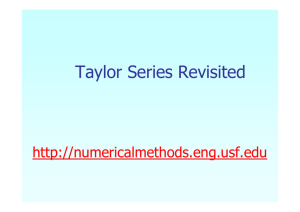Runge-Kutta 2nd Order Method for Solving
advertisement
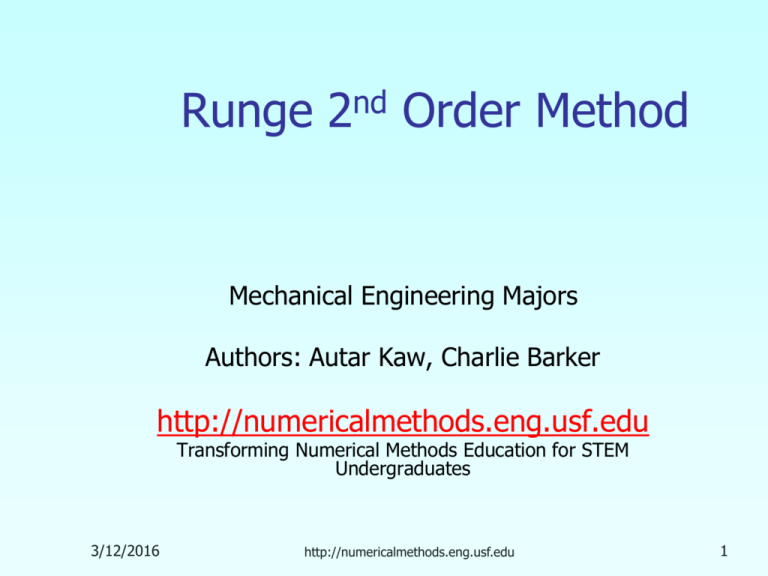
Runge 2nd Order Method Mechanical Engineering Majors Authors: Autar Kaw, Charlie Barker http://numericalmethods.eng.usf.edu Transforming Numerical Methods Education for STEM Undergraduates 3/12/2016 http://numericalmethods.eng.usf.edu 1 Runge-Kutta 2nd Order Method http://numericalmethods.eng.usf.edu Runge-Kutta 2nd Order Method For dy f ( x, y ), y (0) y0 dx Runge Kutta 2nd order method is given by yi 1 yi a1k1 a2 k2 h where k1 f xi , yi k2 f xi p1h, yi q11k1h 3 http://numericalmethods.eng.usf.edu Heun’s Method Heun’s method Slope f xi h, yi k1h y Here a2=1/2 is chosen 1 a1 2 p1 1 Slope f xi , yi q11 1 resulting in 1 1 yi 1 yi k1 k2 h 2 2 where k1 f xi , yi yi+1, predicted Average Slope yi xi 1 f xi h, yi k1h f xi , yi 2 xi+1 x Figure 1 Runge-Kutta 2nd order method (Heun’s method) k 2 f xi h, yi k1h 4 http://numericalmethods.eng.usf.edu Midpoint Method Here a2 1 is chosen, giving a1 0 p1 1 2 q11 1 2 resulting in yi 1 yi k2h where k1 f xi , yi 1 1 k 2 f xi h, yi k1h 2 2 5 http://numericalmethods.eng.usf.edu Ralston’s Method Here a 2 2 is chosen, giving 3 1 3 3 p1 4 3 q11 4 resulting in a1 2 1 yi 1 yi k1 k 2 h 3 3 where k1 f xi , yi 3 3 k 2 f xi h, yi k1h 4 4 6 http://numericalmethods.eng.usf.edu How to write Ordinary Differential Equation How does one write a first order differential equation in the form of dy f x, y dx Example dy 2 y 1.3e x , y 0 5 dx is rewritten as dy 1.3e x 2 y, y 0 5 dx In this case f x, y 1.3e x 2 y 7 http://numericalmethods.eng.usf.edu Example A solid steel shaft at room temperature of 27°C is needed to be contracted so it can be shrunk-fit into a hollow hub. It is placed in a refrigerated chamber that is maintained at −33°C. The rate of change of temperature of the solid shaft q is given by 6 4 5 3 3 2 3 . 69 10 θ 2 . 33 10 θ 1 . 35 10 θ dθ 6 θ 33 5.33 10 2 dt 5.42 10 θ 5.588 q 0 27C Find the temperature of the steel shaft after 24 hours. Take a step size of h = 43200 seconds. dθ 5.33 10 6 3.69 10 6 θ 4 2.33 10 5 θ 3 1.35 10 3 θ 2 5.42 10 2 θ 5.588 θ 33 dt f t,θ 5.33 106 3.69 106 θ 4 2.33 105 θ 3 1.35 103 θ 2 5.42 102 θ 5.588 θ 33 1 2 1 2 q i 1 q i k1 k 2 h 8 http://numericalmethods.eng.usf.edu Step 1: For i 0, t0 0, Solution q0 27 4 3 6 5 3 . 69 10 27 2 . 33 10 27 6 k1 f t0 , q o f 0, 27 5.33 10 27 33 2 1.35 10 3 27 5.42 10 2 27 5.588 0.0020893 k 2 f t0 h, q 0 k1h f 0 43200, 27 0.002089343200 f 43200,63.278 3.69 10 6 63.2784 2.33 10 5 63.2783 6 5.33 10 63 . 278 33 1.35 10 3 63.2782 5.42 10 2 63.278 5.588 0.0092607 1 1 1 0.0020893 1 0.0092607 43200 2 2 2 2 27 0.005675043200 218.16C q1 q 0 k1 k 2 h 27 9 http://numericalmethods.eng.usf.edu Solution Cont Step 2: i 1, t1 43200, q1 218.16C k1 f t1 ,q1 f 43200,218.16 4 3 6 5 3 . 69 10 218 . 16 2 . 33 10 218 . 16 6 5.33 10 218 . 16 33 1.35 10 3 218.162 5.42 10 2 218.16 5.588 8.4304 k 2 f t1 h, q1 k1h f 43200 43200,218.16 8.430443200 f 86400,364410 3.69 10 6 (364410) 4 2.33 10 5 (364410)3 6 5.33 10 364410 33 2 3 2 1.35 10 364410 5.42 10 364410 5.588 1.2638 1017 1 1 1 8.4304 1 1.2638 1017 43200 2 2 2 2 218.16 6.3190 1016 43200 2.7298 10 21C q 2 q1 k1 k 2 h 218.16 10 http://numericalmethods.eng.usf.edu Solution Cont The solution to this nonlinear equation at t=86400s is q 86400 26.099C 11 http://numericalmethods.eng.usf.edu Comparison with exact results Figure 2. Heun’s method results for different step sizes 12 http://numericalmethods.eng.usf.edu Effect of step size Table 1. Effect of step size for Heun’s method Step size, h 86400 43200 21600 10800 5400 q 86400 |t | % Et −58466 58440 −2.7298×1021 2.7298×1021 −24.537 −1.5619 −25.785 −0.31368 −26.027 −0.072214 223920 1.0460×1011 5.9845 1.2019 0.27670 q 86400 26.099C (exact) 13 http://numericalmethods.eng.usf.edu Effects of step size on Heun’s Method Figure 3. Effect of step size in Heun’s method 14 http://numericalmethods.eng.usf.edu Comparison of Euler and RungeKutta 2nd Order Methods Table 2. Comparison of Euler and the Runge-Kutta methods q (86400) Step size, h Euler Heun Midpoint Ralston 86400 43200 21600 10800 5400 −153.52 −464.32 −29.541 −27.795 −26.958 −58466 −2.7298×1021 −24.537 −25.785 −26.027 −774.64 −0.33691 −24.069 −25.808 −26.039 −12163 −19.776 −24.268 −25.777 −26.032 q 86400 26.099C 15 (exact) http://numericalmethods.eng.usf.edu Comparison of Euler and RungeKutta 2nd Order Methods Table 2. Comparison of Euler and the Runge-Kutta methods 16 t % Step size, h Euler Heun Midpoint Ralston 86400 43200 21600 10800 5400 448.34 737.97 14.426 7.0957 3.5755 12216011 5.7292 1.1993 0.27435 1027.6 76.360 7.0508 1.0707 0.22604 23844 42.571 6.6305 1.2135 0.25776 q (86400) 25.217C (exact) 7.9064 10 http://numericalmethods.eng.usf.edu Comparison of Euler and RungeKutta 2nd Order Methods Figure 4. Comparison of Euler and Runge Kutta 2nd order methods with exact results. 17 http://numericalmethods.eng.usf.edu Additional Resources For all resources on this topic such as digital audiovisual lectures, primers, textbook chapters, multiple-choice tests, worksheets in MATLAB, MATHEMATICA, MathCad and MAPLE, blogs, related physical problems, please visit http://numericalmethods.eng.usf.edu/topics/runge_kutt a_2nd_method.html THE END http://numericalmethods.eng.usf.edu

